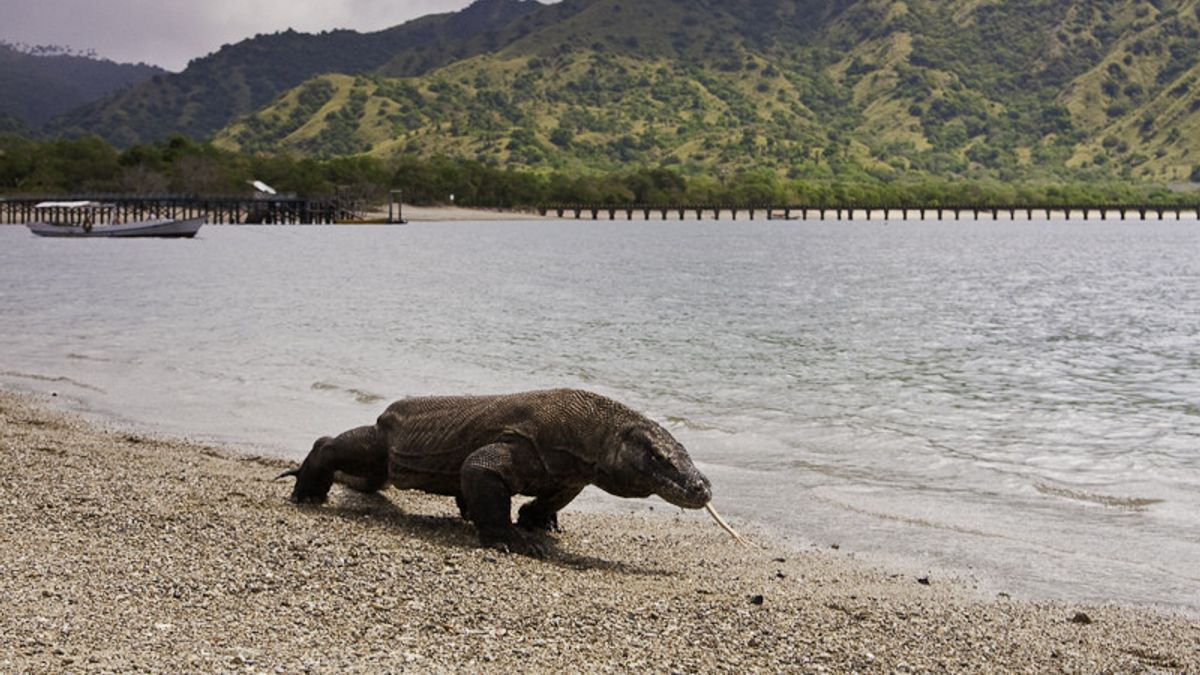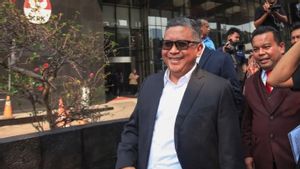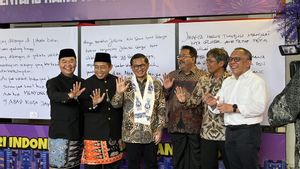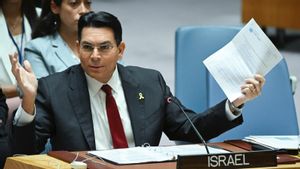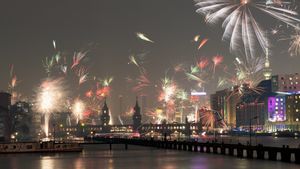JAKARTA - Komodo National Park, East Nusa Tenggara is the habitat of Komodo dragons. The number of giant lizards endemic to this area, according to data from the Ministry of Environment and Forestry (KLHK) in 2021, will reach more than 3,000 individuals. The majority of its habitat is spread over three islands: Komodo Island, Rinca Island, and Padar Island.
Komodo is an ancient lizard that has lived throughout Indonesia and Australia. Its existence is not found anywhere else. Not surprisingly, the Komodo National Park has been awarded the title of world heritage site from UNESCO since 1991.
Currently, infrastructure development to turn the area into a premium tourist attraction in Indonesia is underway. However, in the process, UNESCO assessed that there were still some things that would threaten the title.
The Chief Natural Heritage Unit of UNESCO, Guy Debonnet, considers that the Indonesian government is not transparent about the study of tourism projects. UNESCO is concerned that it will have a negative impact on the environment and Komodo dragon habitat in the area.
"This is definitely a project of concern, as we feel that its impact on the universal value (of national parks) has not been properly evaluated," he said.

In a UNESCO recommendation presented at the 44th World Heritage Committee session which took place in Fuzhou, China on 16-31 July 2021, UNESCO urged Indonesia to stop tourism infrastructure projects in and around the Komodo National Park site. For this reason, the project has a potential Outstanding Universal Value (OUV) impact.
OUV is one of UNESCO's assessment criteria for the designation of world heritage. UNESCO also asked Indonesia to submit a revised Amdal for the project which would then be reviewed by the International Union for Conservation of Nature (IUCN). The document must also contain a description of the integrated tourism master plan showing how UOV properties are protected.
The Director General of Conservation of Natural Resources and Ecosystems of the Ministry of Environment and Forestry, Wiratno conveyed that the process of improving the Environmental Management Efforts (UKL) and Environmental Monitoring Efforts (UPL) to conform to the rules set by the IUCN was underway. The target for submitting the entire Environmental Impact Assessment (EIA) document to the World Heritage Center is the end of August or early September 2021. So that it can be reviewed by the IUCN and WHC before the 45th WHC Session in 2022.
"But before [the EIA document] was examined, [UNESCO] had already made a decision [in the form of a warning document to Indonesia], and we have no right to explain. UNESCO should have asked the Indonesian government to double-check the data it received from other parties," said Wiratno quoted from bbc.com.
UNESCO and IUCN Take NoteTo be sure, UNESCO and IUCN had a chance to visit the Komodo National Park directly on March 3-6 2022. According to Wiratno, there were several locations visited, including the Loh Buaya Resort on Rinca Island, the South Padar resort on Padar Island, and the Loh Liang resort. on Komodo Island.
"The UNESCO and IUCN teams had the opportunity to directly observe the arrangement of natural tourism infrastructure carried out by the Ministry of PUPR at Loh Buaya Resort. The UNESCO and IUCN teams stated that previously they did not understand the terminology "Resort" used to describe the guard post for the rangers," said Wiratno, quoted from liputan6 .com.
"The EIA expert team conveyed that there was no significant environmental damage impact on both terrestrial and aquatic ecosystems as alleged by third parties. The UNESCO and IUCN teams even expressed their appreciation for the quality of the Environmental Impact Assessment (EIA) and Environmental Management Plan (EMP) documents compiled by The EIA expert team is structured and based on scientific data referring to the IUCN Guidelines," continued Wiratno.

However, according to the official website of the Ministry of the Environment, there are some notes. The IUCN and UNESCO TEAM suggested that natural tourism business planning in Komodo National Park be added to the Integrated Tourism Master Plan (ITMP) document so that it becomes a planning unit that complements each other.
Indeed, the Government of Indonesia continues to be committed to preserving the OUV values of Komodo National Park through the implementation of various programs and policies at the field level.
“This is stated in the Park Management Plan as a national conservation area and a UNESCO World Natural Heritage Site. This management plan operates under five conservation principles, namely regulation-based, science-based, evidence-based, experience-based, and precautionary principle," said Wiratno.
Protest ContinuesAfter UNESCO, a number of environmental and conservation activists, as well as local communities also protested the construction of premium tourism objects in Komodo National Park. Moreover, when President Jokowi said that the ticket price rose from a maximum of Rp. 200,000 to Rp. 3.75 million as of August 1, 2022.
"We ask Mr. Jokowi to cancel the plan to increase the entrance ticket price for Komodo National Park, which is planned to take effect on August 1, 2022," said Astindo Labuan Bajo Chairman, Ignasius Suradin, quoted from Kompas.com, Friday (22/7).
Suradin also requested that the management of Komodo National Park not be handed over to a third party. "Revoke all permits from private companies that have plotted the Komodo National Park."

There are at least two listed companies that have obtained permits. First, PT Komodo Wildlife Ecotourism (KWE) received a 426.7 hectare land concession on Padar Island and Komodo Island through the Decree of the Minister of Forestry 796/MENHUT-II/2014 issued on 29 September 2014.
Second, PT Segara Komodo Lestari (SKL) obtained a land management permit for 22.1 hectares on Rinca Island based on the BKBKPM letter number 7/1/IUPSWA/PMDN/2015 and the Komodo National Park Office SK number 169/T.17/TU/KSA/ 04/2018.
"The latest decree, based on records from the Wahana Lingkungan Hidup (Walhi), is a permit for the provision of natural tourism facilities with a contract period of 52 years," wrote CNN Indonesia.
Then in 2019, the Ministry of Environment and Forestry issued a new Ministerial Regulation number P.8/MENLHK/Setjen/KUM.1/3/2019 concerning permits for natural tourism exploitation in wildlife reserves, national parks, forest parks, and natural tourism parks. Through this regulation, the entire IPPA licensing process goes through the online single submission (OSS) system. In addition, the Ministry of Environment and Forestry shares authority with the Ministry of Maritime Affairs and Investment, the Ministry of Tourism and the NTT Government to organize Komodo Island as an exclusive tourist destination.
Iksan, a resident of Komodo Village also considers the price of admission to Komodo Island to be too expensive. Only affordable for the upper middle class. He also disagreed with the statement from the NTT Provincial Government that there had been a decline in the value of ecosystem services on Komodo and Padar Islands, so they had to limit visitors to only 200,000 per year.

"This policy is very detrimental to the economy of the Komodo community, 90 percent of whom are tourism actors," explained Iksan during a speech at the Komodo National Park Office Courtyard, quoted from kompas.com, Monday (18/7).
Director of National WALHI, Nur Hidayati in a written statement at walhi.or.id, assessed that the government should facilitate not kill the current livelihoods of local people who are willing to switch from fishermen to tourism actors. It is a must for the Government to involve the community as the main actor, especially the Ata Modo community who really understand the situation of the conservation area and have respect for the Komodo dragon and its entire ecosystem.
Management or regulation is needed so that tourism can be in accordance with the carrying capacity and capacity of the environment and does not disturb the Komodo dragon ecosystem.
"The arrangement must also involve local communities who have been tourism actors, not then side with large-scale entrepreneurs who will have a social impact on the community," he said.
Data BasedMinister of Tourism and Creative Economy Sandiaga Uno also wants the development of the Komodo National Park super priority destination to involve local communities.
“Prioritizing conservation while still opening up economic opportunities with local wisdom. This is what we encourage in the concept of quality and sustainable tourism," said Sandiaga Uno at the Ministry of Tourism's Weekly Press Briefing (WPB) on Monday, July 18, 2022, quoted from Tempo.co.
As for the ticket price of Rp3.75 million, this is only for conservation areas. While the island for tourist purposes remains the same. Launching from katadata.com, the figure of Rp3.75 is referred to as the Conservation Contribution Cost (BKK). Referring to the calculation of 20 factors of ecosystem services by taking into account the conservation of Komodo Island and the economic side of the surrounding community.
"The determined BKK value applies to both foreign tourists and foreign tourists. Tourists only need to pay BKK once per year and can return to KNP repeatedly to visit Komodo Island and Padar Island. However, you still have to register and check your quota through the application,” said the Coordinator of the KNP Function Strengthening Program, Carolina Noge on July 11.

Because, there are restrictions on the number of visitors to the conservation area. If you don't want to issue a BKK, the East Nusa Tenggara Provincial Government directs tourists to visit Rinca Island and Kelor Island.
The visitor restriction refers to the results of the study on the carrying capacity of the tourism capacity (DDDTW) based on ecosystem services on Komodo Island and Padar Island which was carried out by the Directorate General of Natural Resources and Ecosystem Conservation of the Ministry of Environment and Forestry through the Komodo National Park Center (BTNK).
The ideal number of visitors per year is only 219,000 tourists to Komodo Island and 39,420 tourists to Padar Island or about 100 people per visit.
"The results of the study show that the number is almost the same as the level of visits in 2019 (i.e. 221,000 people) for Komodo Island, while on Padar Island the Komodo National Park Office has implemented a policy of visiting 100 people per visit, in 1 day. there are 3 times of visit," Deputy Minister of Environment and Forestry, Alue Dohong in a press release on June 26, 2022.
The number of visits to Padar Island can be up to 2–2.5 times, taking into account several things related to the adjustment of carrying capacity in the form of infrastructure, such as increasing the number of posts in the trekking area, sanitation facilities and toilets, safety trekking such as ropes, the number of rangers and medical and medical personnel. special room for health.

"This visitor arrangement with a visitor restriction system or visitor quota is of course intended to minimize the negative impact of natural tourism activities on the preservation of the Komodo dragon population and other wildlife, maintain the sustainability of the ecosystem on Komodo Island and Padar Island in particular, as well as to maintain the comfort and safety of visitors and officers during their activities in Komodo National Park," explained the Deputy Minister of Environment and Forestry.
The results of intensive monitoring by the Komodo National Park Rangers and researchers at the Komodo Survival Program Foundation stated that there were differences in the behavior of Komodo dragons in tourist and non-tourist areas.
Komodo dragons in tourist areas tend to be close to humans. Body weight can reach 100 kg. Unlike the Komodo dragons in non-tourism areas, the largest is only 79 kg. This body weight certainly affects the ability of Komodo dragons to survive in the wild. The heavier it is, the harder it is to hunt down prey. This weight also affects the cruising range of the Komodo dragon.
"This is why we have to maintain stability, not only the ecosystem, including the Komodo dragon itself and the original behavior of the Komodo dragon," said Head of the Komodo National Park Office, Lukita Awang, quoted from mediaindonesia.com.
The Expert Team for the Study of Carrying Capacity Based on KNP Ecosystem Services, projects that the number of tourists to KNP can reach 283,686 in 2030, an increase of more than five times compared to the realization in 2020 of 49,719 people. The figure is expected to rise again by 68.93 percent in 2045 to 479,240.
Tourist visits during the last four years, from 2017-2020 were only around IDR 567,253 people or an average of 100 thousand visitors per year.
President Jokowi asked that the issue of increasing ticket prices does not widen. After all, the desire to conserve Komodo dragons is also based on expert input.
"So we want conservation but we also want the economy through tourism, through tourists. This must be balanced, Labuan Bajo is lucky because the Komodo dragon doesn't only live on one island, it's on Komodo Island, it's on Rinca Island here. It's on Padar Island conservation," said President Jokowi through the Presidential Secretariat's YouTube channel, Thursday (21/7).
The English, Chinese, Japanese, Arabic, and French versions are automatically generated by the AI. So there may still be inaccuracies in translating, please always see Indonesian as our main language. (system supported by DigitalSiber.id)
